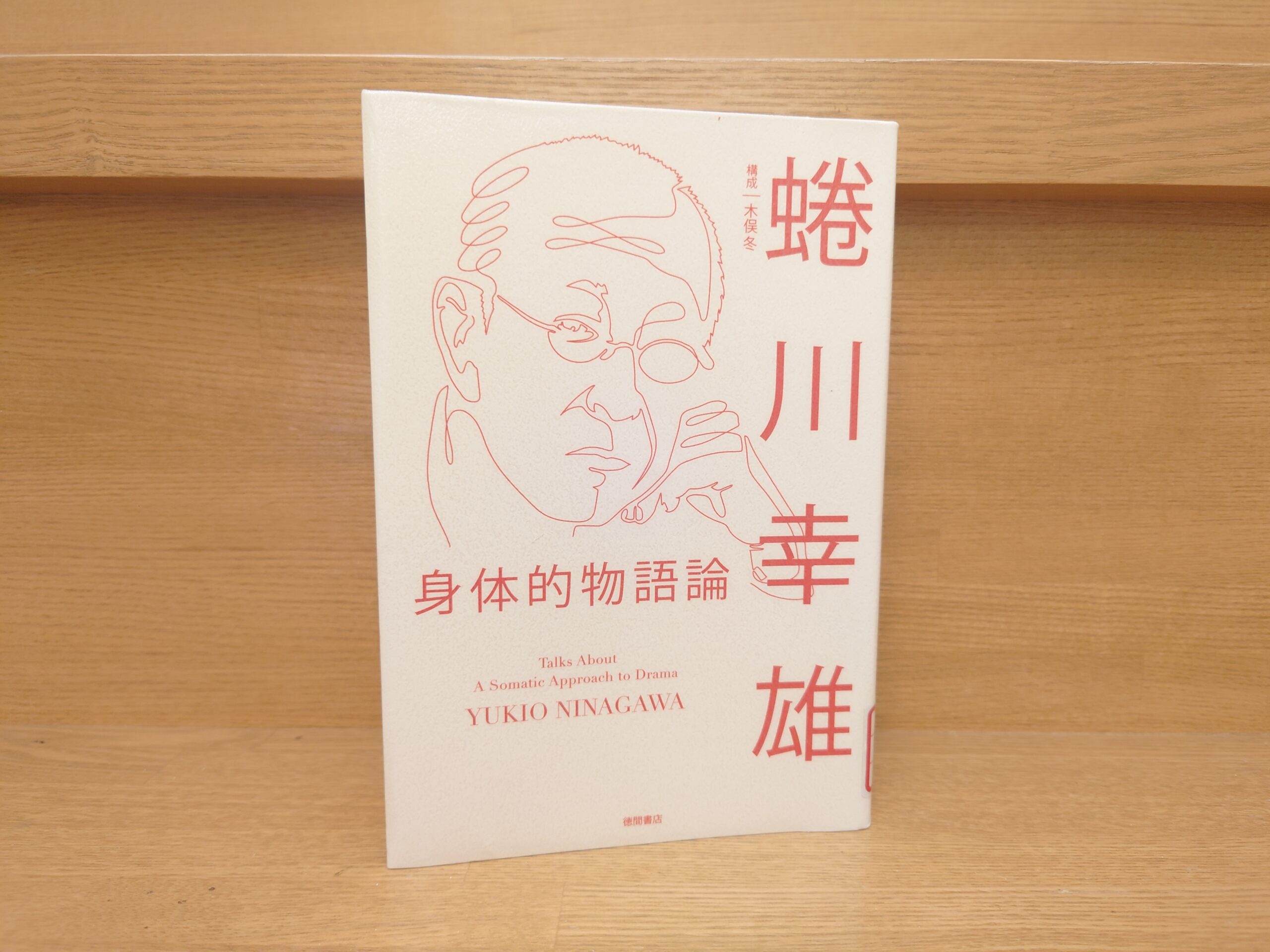Yukio Ninagawa's "Physical Narrative Theory" Summary and Impressions - What does the master think about the Japanese people and their times today?
We are pleased to present "Bodily Narrative Theory" by Yukio Ninagawa, published by Tokuma Shoten in 2018.
Let's take a quick look at the book.
World-renowned director Yukio Ninagawa passed away in May 2016. This book is a collection of his reflections on "body" and "story" that he left behind before his death. In his nearly 60 years of theatrical life, he looked at the bodies of actors who symbolize the modernity of the Japanese people. Ninagawa's discussion of the actor's body is a discussion of the times, as well as an examination of the nature of human existence. This book is a re-edited version of a magazine article and includes an interview with Ninagawa that was written exclusively for this book. The book also includes a report by Fuyu Kimata, who has collected testimonies from people involved in the project.
AmazonProducts Page.
This book is a collection of Yukio Ninagawa's reflections on the "body" and "narrative. The title "Bodily Narrative" may sound philosophical and difficult, but this is not the case at all. The author of the book, Fuyu Kimata, says at the end of the book as follows.
The majority of Yukio Ninagawa's talks in this book were originally published in the (now defunct) magazine Magna Carta (Village Book, edited by Katsuhiko Shimaji), which was launched in 2012 with the aim of having Ninagawa share his views on life and the body through his theatrical activities, and was titled "The Japanese Body" during the series. The series was titled "The Japanese Body.
This is not a "theory of the body" aimed primarily at people who are familiar with or familiar with theater, but rather a response to the desire of Yutaro Hirai of the editorial department and myself, who was in charge of the structure, that people who do not usually watch theater would read how Ninagawa's plays capture the Japanese people and their times.
Ninagawa always said that he would accept interviews with any media, whether it be a major newspaper or a local town magazine, as long as he had time. I feel that he responded well to people who did not have the opportunity to have much contact with Ninagawa. As you mention in the book, perhaps it is because you remember that when you were isolated in the theater world, writers in other media than the theater world supported your plays.
I think that Ninagawa chose practice over theory, and that the "Japanese body" is not only unique to each individual, but is first and foremost a "mind", and by giving specific examples of this, each individual's story emerges. By giving specific examples of this, I think the content of each individual's story came to the fore. In the rehearsal hall, Tatsuya Fujiwara, who plays Hamlet, said to me, "Just believe in the loudness of your voice," and I think that is all that matters.
Tokuma Shoten, Yukio Ninagawa, Bodily Narrative Theory, p. 204-205.
I hope that people who are not familiar with the theater will read about how Ninagawa's plays capture the Japanese people and the times, rather than just reading about the physicality of the body.
As stated above, this book is not a philosophical treatise by a specialist, but is designed to be read easily by those who are not normally familiar with theater.
Indeed, when you read this book, you will not find any difficult technical terms or philosophical discussions. Each story is familiar and concrete and very easy to understand.
As an example, I would like to share with you a passage in which Ninagawa talks about today's youth.
Today's young people - mainly those under the age of 30 - all have a similar figure and skin feel. They are uniformly thin, with a high center of gravity, smooth skin, and monotonous expressions. Their voices are quiet. I have noticed this tendency in the activities of Saitama Next Theater, a theater troupe for young people in their teens to 30s, in addition to the activities of a theater troupe for the elderly. This is especially noticeable among the young people who have been auditioning for the last couple of years. Even when I watch TV, I see that they all look alike. I call them "pencils" or "asparagus. Hiroki Hasegawa (born in 1977), who recently attracted attention with his drama "Suzuki Sensei," has a herbivorous body that is representative of modern people, and I think that is why he is used so heavily in the world of images that depict the present. (omitted).
In the 1970s, everyone had a different face and body. When Renji Ishibashi and Keizo Kanie (born in 44) were young, they looked lumpy and dirty, just like that look they have today, but younger. Kanie looked like a potato, and Renji looked like moss growing on his face. Their bodies in the seventies had a bumpy, rough skin sensation. When reality and one's own body came into contact with each other, they bled like they had been sanded. Such was the skin sensation. Even in the old days, actresses with thin and contorted bodies like Madako Midori were rare, and Mayama had a body that is still recognizable today. I think the 1970s was a time when such diverse characters could come together in one place and make it work. (omitted).
I think that today's young people have a body that does not make enemies. I haven't met any young people recently whose bodies have a primitive sense of resistance or frayed nerves. I wonder if they want to conform to this society so badly. I, for one, would like to make a small contribution to this unpleasant world.
There are many young people who train their bodies, but I don't think they have the bodies to compete with the rest of the world. Even Shun Oguri (born in 1982), who played the top of the delinquent group in movies such as "Close Zero," is still a minor delinquent in my view. A body that can fight the world is a body that can survive in the jungle or in the city, a body that can withstand all kinds of hardships. But young people have enlarged abdominal muscles and upper bodies. That is a fake body. If you make a play move in slow motion, it reveals a lie. Slow motion is a technique to instantly highlight the uniqueness of a large number of people, like Eisenstein's portrayal of the people in his film "The Battleship Potemkin" through montage. To do this, the center of gravity must be lowered a little to stabilize the body, but young people are not very good at this and easily fall down. This tendency, which can be called a kind of aging, may be a side effect of the increase in digital brain work, or it may be because we don't use our bodies as much as we used to in our daily lives and we are obsessed with training our upper bodies.
Tokuma Shoten, Yukio Ninagawa, Bodily Narrative Theory, p. 15-21.
How about this? It's very easy to understand, isn't it? And yet, in the second half of the above quote, you can also hear Ninagawa's own words in relation to the theater. Even if you know little about theater, you can still find yourself saying, "Oh, I didn't know that! Even if you know little about theater, you can still discover something new in this episode.
Then, in the middle of the quote, it was said,I think that today's young people have bodies that don't make enemies. I haven't met any young people recently whose bodies have a primitive sense of resistance or frayed nerves. I wonder if they want to conform to this society so badly. I, for one, would like to make a small dent in this unpleasant world."The words.
In the past, Japan was full of unique people, and there were many rugged and rough people around. But now?
The more loudly adults shout "individuality is important" and "let's just be who we are," the more "quiet people" with no individuality are being mass-produced. Ninagawa seems to have clearly seen this trend.
Obviously, it is impossible to generalize all of this, but as a "trend of the times," this is a very significant recommendation.
In this book, Ninagawa talks about the present day in such a concrete and easy-to-understand manner. The title may make some of you gasp, but we encourage you to pick up a copy.
This is "Yukio Ninagawa's Theory of Physical Narrative: What does the master think about the Japanese people and their times today? What does the master think about the Japanese people of today and their times, and his suggestions for us as seen through theater?
Next Article.
Click here to read the previous article.
Related Articles







































